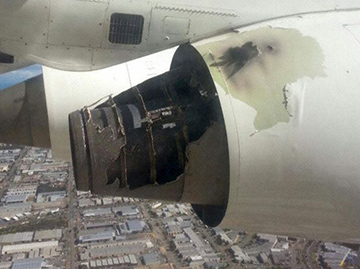Metal fatigue caused a welded boss on the No.2 engine to give way, resulting in a fuel-fed fire that was brought under control by the flight crew.

On 29 April 2014 an AVRO 146-RJ100 aircraft, registered VH‑NJI and operated by Cobham Aviation Services Australia (Cobham), was on a charter flight to Barrow Island Airport from Perth Airport, Western Australia. The aircraft sustained a mechanical failure of the No. 2 engine shortly after take-off that resulted in an in-flight fuel-fed engine fire.
The flight crew extinguished the engine fire by shutting down the No. 2 engine and activating the fire suppression system. The aircraft was flown back to Perth Airport, having sustained significant damage to the No. 2 engine and cowling. There were no injuries.
The Honeywell International Inc (Honeywell) LF507-1F (LF507) engine has four combustion liner locating pin welded bosses (welded boss) in the combustor turbine module (CTM) combustor housing (housing). The ATSB found that the welded boss located at the 2 o’clock position had cracked and fractured adjacent to the weld as a result of fatigue. The boss separated from the housing, allowing high-pressure combusting fuel to escape radially through the CTM housing, burning through the engine cowling.
The ATSB found that the normal scheduled visual inspection of the housing, which was designed to find cracks before they developed into a fracture, was ineffective in this case.
The ATSB also found that localised grinding of the inner and outer surfaces of the CTM housing, adjacent to the welded boss, had reduced its wall thickness from 0.050 to 0.035 inches. The reduced wall thickness increased local stresses and hence the likelihood of crack formation. The crack accelerated at an unpredictable rate until penetrating the full thickness of the housing. It is likely that the grinding was associated with a weld repair conducted during a CTM heavy maintenance visit. The grinding repair was not an acceptable repair to Honeywell for returning the component to the original design strength.
Finally, the ATSB found that the normal scheduled visual inspection of the housing, which was designed to find cracks before they developed into a fracture, was ineffective in this case. This was because the reduced wall thickness invalidated the original crack growth rate predictions.
In response to this occurrence Cobham proactively inspected all of their LF507 engines, focusing on the welded bosses. Of those engines, one spare engine had grinding at one of the welded bosses, similar to the occurrence engine, and was withdrawn from the availability pool. Although no cracking was found at the combustion liner location pin welded bosses, Cobham did find seven cracks at the location of the ignition bosses that had not been previously identified. These cracks were managed in accordance with the Honeywell maintenance manual.
Honeywell also instigated several actions in response to this occurrence. These included amendment of the LF507 engine maintenance and overhaul manuals to address crack limits and weld repair specifications, and the issue of a Service Bulletin to alert operators of possible welded boss cracking.
Safety message
This occurrence highlights the importance of repairing aircraft components in accordance with the manufacturer’s specifications and ensuring that the repair meets the design intent of the manufacturer.
Read the final report: In-flight engine fire involving AVRO 146-RJ100, VH-NJI, departing Perth Airport, Western Australia, on 29 April 2014


